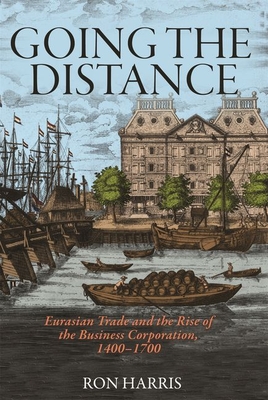

 Princeton University Press
Princeton University Press
Going the Distance: Eurasian Trade and the Rise of the Business Corporation, 1400-1700


Key Metrics
- Ron Harris
- Princeton University Press
- Hardcover
- 9780691150772
- 9.3 X 6.4 X 1.5 inches
- 1.8 pounds
- Business & Economics > Economic History
- English
 Secure Transaction
Secure TransactionBook Description
A historical look at the early evolution of global trade and how this led to the creation and dominance of the European business corporation
Before the seventeenth century, trade across Eurasia was mostly conducted in short segments along the Silk Route and Indian Ocean. Business was organized in family firms, merchant networks, and state-owned enterprises, and dominated by Chinese, Indian, and Arabic traders. However, around 1600 the first two joint-stock corporations, the English and Dutch East India Companies, were established. Going the Distance tells the story of overland and maritime trade without Europeans, of European Cape Route trade without corporations, and of how new, large-scale, and impersonal organizations arose in Europe to control long-distance trade for more than three centuries.
Ron Harris shows that by 1700, the scene and methods for global trade had dramatically changed: Dutch and English merchants shepherded goods directly from China and India to northwestern Europe. To understand this transformation, Harris compares the organizational forms used in four major regions: China, India, the Middle East, and Western Europe. The English and Dutch were the last to leap into Eurasian trade, and they innovated in order to compete. They raised capital from passive investors through impersonal stock markets and their joint-stock corporations deployed more capital, ships, and agents to deliver goods from their origins to consumers.
Going the Distance explores the history behind a cornerstone of the modern economy, and how this organizational revolution contributed to the formation of global trade and the creation of the business corporation as a key factor in Europe's economic rise.
Author Bio
Ron Harris is the Kalman Lubowsky Professor of Law and History, and former Dean, at the Faculty of Law in Tel-Aviv University.
His main research field is the history of the business corporation. He studies the business corporation in Britain and comparatively, and in the wider context of legal and economic history, the history of industrialization, capitalism, colonialism and globalization. He also works on the history of other forms of business organization (partnerships, commenda, etc.) and of other legal-economic institutions (contracts, property rights, etc.). His additional research interests include the methodology of legal-economic history, the history and policy of bankruptcy and consumer credit, and Israeli legal history.
He earned an LL.B., and B.A. and M.A. in history from TAU and a Ph.D. in history from Columbia University. Harris was a Fellow at the Institute for Advanced Study in the Behavioral Sciences at Stanford University (2017-18). He was a visiting professor at UC Berkeley, USC, Cornell University, École Normale Supérieure in Paris, London School of Economics, HEC Business School in Paris and NALSAR Hyderabad and spent extended research periods as a visiting fellow in Oxford. Harris is a co-founder of the Israeli Legal History Association and the President of the Economic History Association of Israel.
Harris is the author of three books: Going the Distance: Eurasian Trade and the Rise of the Business Corporation, 1400-1700 (2020); Industrializing English Law: Entrepreneurship and Business Organization, 1720 – 1844 (2000); Israeli Law: The Formative Years 1948-1977 (2014). He is the editor of two other books and the author or co-author of numerous articles in economics, business, history and law journals.
He is currently working on a book project on the comparative history of private companies in France, Germany, Britain, and the US (with Naomi Lamoreaux, Timothy Guinnane and Jean-Laurent Rosenthal) and on a book project on the expansion of company law from Britain to its global Empire between 1815-1914.
Source: Tel Aviv University
Videos
No Videos
Community reviews
Write a ReviewNo Community reviews